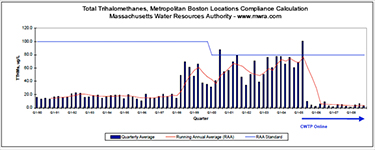FOR IMMEDIATE RELEASE
Ria Convery, Communications Director
(617) 788-1105, <ria.convery@mwra.state.ma.us>
DPBs NOT A CONCERN IN MWRA DRINKING WATER
|
The level of disinfection by-products in MWRA water is at an all-time low. With the start-up of the Carroll Water Treatment Plant in 2005 and the use of ozone instead of chlorine for primary disinfection, the level of disinfection by-products in water supplied by MWRA has dropped dramatically. MWRA has always met the standards for disinfection by-products, but with ozonation, the new levels of disinfection by-products are even further below current and future standards.
Disinfection By-Products (DBPs) are formed when disinfectants such as chlorine -- effectively used to control disease-causing pathogens -- mix with naturally occurring organic substances in the source water. There are several types of products formed, with trihalomethanes (THMs) and haloacetic acids (HAAs) of most concern.
MWRA follows the levels of DBPs in the water closely. Based on sampling at compliance sites, disinfection by-product levels have dropped by over 80%, with THM and HAA levels now averaging less than 10 ug/L. The present Massachusetts Department of Environmental Protection and Environmental Protection Agency standards require that the running annual average (average of past four quarters) not be over 80 ug/L for THMs and not be over 60 ug/L for HAAs. MWRA has always met this standard. With the startup of the CWTP in July 2005, MWRA water now meets the newly issued EPA standards (December 2005), 6 to 8 years ahead of when they will become effective.
Below is a graph of THM levels over the last 18 years. These levels were relatively low prior to 1997-1998, and rose when improved disinfection practices to inactivate certain pathogens (germs) of concern were implemented. DBP levels rose until ozone treatment was ready to come on-line. Over this period inactivation of Giardia was improved significantly, and inactivation of Cryptosporidium was met once ozone was used as the primary disinfectant. With ozone, DBP levels are even lower than before disinfection improvements.
|
MWRA drinking water comes from the Quabbin and Wachusett Reservoirs in Central Massachusetts.
MWRA routinely tests for 122 contaminants. Overall testing results for 2008 will be published in MWRA’s Annual Water Quality Report distributed this June to every household in MWRA’s water service area.
Copies of prior annual reports are available online at www.mwra.com or by calling 617-242-5323.
###
Updated June 11, 2009
